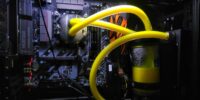SSD Vs. Pcie SSD: Comparing High-Speed Storage Solutions
This article aims to provide an objective and impersonal analysis of the differences between SSD (Solid State Drive) and PCIe SSD (Peripheral Component Interconnect Express Solid State Drive) as high-speed storage solutions.
In recent years, advancements in technology have significantly improved data storage options, leading to the emergence of faster and more efficient storage devices. Understanding these technologies is crucial for individuals and businesses seeking optimal performance from their data systems.
The article will begin by explaining the fundamentals of SSD technology, highlighting its key features and benefits. It will then delve into an exploration of PCIe SSDs, specifically focusing on their advantages over traditional SSDs.
A comprehensive performance comparison between the two types of drives will be provided, considering factors such as speed, latency, and reliability.
Furthermore, this article will discuss essential considerations when selecting a storage solution, including price, capacity requirements, compatibility with existing systems, and installation processes.
Lastly, it will touch upon future trends in high-speed storage solutions to help readers make informed decisions regarding whether an SSD or PCIe SSD is best suited for their needs.
Key Takeaways
- SSD technology offers faster data access, durability, and energy efficiency compared to traditional hard disk drives.
- PCIe SSDs outperform SATA SSDs in terms of speed, latency, and access time.
- PCIe SSDs offer increased bandwidth, scalability, parallelism, lower power consumption, and future-proofing compared to traditional SSDs.
- Factors to consider when choosing a storage solution include speed, cost, capacity, reliability, and compatibility with existing systems.
Understanding SSD Technology
SSD technology has revolutionized the storage industry by offering faster data access, greater durability, and improved energy efficiency compared to traditional hard disk drives.
Unlike HDDs, which rely on mechanical components to read and write data, SSDs use flash memory chips that store information electronically. This eliminates the need for moving parts, resulting in significantly faster data transfer rates and reduced latency.
Additionally, SSDs are more resistant to physical shock and vibration, making them ideal for portable devices or environments prone to movement.
Moreover, SSDs consume less power and generate less heat than HDDs, leading to improved battery life and a smaller carbon footprint.
As a result of these advantages, SSDs have become the preferred choice for high-speed storage solutions in various applications such as laptops, servers, and gaming consoles.
Exploring the Benefits of PCIe SSDs
Utilizing the advanced PCIe interface, high-speed storage solutions offer a remarkable improvement in data transfer rates and overall system performance. The benefits of PCIe SSDs are manifold:
-
Increased Bandwidth: PCIe SSDs provide significantly higher bandwidth compared to traditional SATA-based SSDs, allowing for faster data access and reduced latency.
-
Enhanced Scalability: With multiple lanes available on the PCIe interface, it is possible to achieve greater scalability by adding more drives or expanding storage capacity.
-
Improved Parallelism: PCIe SSDs leverage parallel data paths, enabling simultaneous read and write operations, which enhances efficiency and reduces bottlenecks.
-
Lower Power Consumption: Thanks to their efficient design, PCIe SSDs consume less power than other storage solutions while still delivering high-performance results.
-
Future-proofing: By utilizing the latest technology standards, such as NVMe (Non-Volatile Memory Express), PCIe SSDs ensure compatibility with future advancements in storage technology.
Overall, the adoption of PCIe SSDs offers tangible benefits in terms of speed, scalability, power efficiency, and future-proofing for high-speed storage solutions.
Performance Comparison: SSD vs. PCIe SSD
When evaluating the performance difference between traditional solid state drives and those utilizing the PCIe interface, a comprehensive analysis reveals distinct variations in data transfer rates and overall system efficiency. SSDs typically connect to the computer via SATA, which limits their bandwidth to around 600 MB/s. On the other hand, PCIe SSDs connect directly to the motherboard’s PCIe slots, allowing for much higher data transfer rates. These high-speed storage solutions can achieve sequential read and write speeds of over 3 GB/s, significantly outperforming their SATA counterparts. Additionally, PCIe SSDs offer lower latency and faster access times due to their direct connection to the CPU. This improved performance translates into faster boot times, quicker application launches, and smoother multitasking experiences. The following table compares key performance metrics between SSDs and PCIe SSDs:
| Metric | SATA SSD | PCIe SSD |
|---|---|---|
| Data Transfer Rate | Up to 600 MB/s | Over 3 GB/s |
| Latency | Higher | Lower |
| Access Time | Slower | Faster |
Overall, when it comes to performance, PCIe SSDs clearly have an edge over traditional SSDs in terms of speed and responsiveness.
Factors to Consider When Choosing a Storage Solution
One important aspect to consider when selecting a storage solution is the impact it can have on overall system performance and efficiency.
Several factors should be taken into account when making this decision. The first factor to consider is the speed of the storage solution. PCIe SSDs generally offer faster speeds compared to traditional SSDs due to their direct connection with the motherboard.
However, it is also essential to consider the specific needs and requirements of the system in question. Factors such as cost, capacity, and reliability should also be taken into consideration. Additionally, compatibility with existing hardware and software may influence the choice of storage solution.
Ultimately, a comprehensive evaluation of these factors will help determine which storage solution is most suitable for a given system’s needs.
Price and Capacity Considerations
Considering the factors of price and capacity is crucial when selecting an appropriate storage solution for optimal system performance and efficiency.
Price plays a significant role in decision-making, as it determines the affordability of a storage solution. SSDs tend to be more expensive than traditional hard drives, but their prices have been declining over time. PCIe SSDs, on the other hand, are generally more costly than SATA SSDs due to their faster speeds and higher capacities. It is important to assess whether the increased speed and capacity offered by PCIe SSDs justify their higher price tag.
Capacity is another key consideration, as it determines how much data can be stored on the drive. Users should evaluate their storage needs and choose a solution that provides adequate space for current and future requirements without compromising on performance or breaking the bank.
Compatibility and Installation Process
Compatibility and the installation process are important factors to consider when selecting a storage solution, as they determine whether the chosen solution will seamlessly integrate with existing hardware and software systems, ensuring a smooth transition and optimal performance.
Compatibility refers to the ability of the storage solution to work effectively with the computer’s motherboard, operating system, and other components. PCIe SSDs generally offer better compatibility compared to traditional SSDs, as they use the PCIe interface commonly found in modern computers.
Moreover, installing a storage solution should be straightforward and hassle-free. PCIe SSDs often require additional steps such as updating firmware or configuring BIOS settings for optimal performance. It is essential to consider these factors before making a decision to ensure that the selected storage solution is compatible and can be easily installed without causing any disruptions or complications.
-
Seamless integration: The ability of a storage solution to seamlessly integrate with existing hardware and software systems ensures efficient data transfer and uninterrupted workflow.
-
Improved performance: A compatible storage solution enhances overall system performance by leveraging existing resources effectively.
-
Peace of mind: Easy installation process minimizes downtime, reduces technical issues, and provides peace of mind for users worried about complex installations.
Overall, considering compatibility and installation processes when choosing between SSDs and PCIe SSDs helps ensure a smooth transition while maximizing system performance.
Future Trends in High-Speed Storage Solutions
Advancements in technology have paved the way for future developments in storage solutions, revolutionizing data transfer and system performance.
One key trend in high-speed storage solutions is the increasing adoption of PCIe SSDs over traditional SATA-based SSDs. PCIe (Peripheral Component Interconnect Express) offers significantly higher bandwidth and lower latency compared to SATA, allowing for faster data access and improved overall system responsiveness. Additionally, PCIe SSDs can support multiple lanes, enabling even greater speed gains.
Another emerging trend is the development of non-volatile memory express (NVMe) technology, which further enhances the performance of PCIe SSDs by optimizing their communication with the computer’s CPU. NVMe reduces latency and increases throughput, resulting in even faster and more efficient data transfers.
These advancements suggest a promising future for high-speed storage solutions as they continue to evolve and push the boundaries of data storage capabilities.
Making an Informed Decision: SSD or PCIe SSD?
When deciding between different storage options, it is important to weigh the advantages and disadvantages of both traditional SATA-based SSDs and the newer PCIe SSDs.
-
Performance: PCIe SSDs offer significantly higher data transfer rates compared to SATA-based SSDs, resulting in faster boot times and improved overall system performance.
-
Scalability: PCIe SSDs allow for greater scalability as they can be easily added or upgraded without having to replace the entire storage solution.
-
Compatibility: SATA-based SSDs are more widely compatible with older systems, while PCIe SSDs require a motherboard that supports the PCIe interface.
-
Cost: SATA-based SSDs tend to be more cost-effective than PCIe SSDs due to their simpler design and wider availability.
-
Future-proofing: Investing in a PCIe SSD ensures compatibility with future technologies and advancements in high-speed storage solutions.
Considering these factors will help individuals make an informed decision when choosing between traditional SATA-based SSDs and the newer PCIe SSDs.
Frequently Asked Questions
Are there any potential drawbacks or disadvantages of using PCIe SSDs compared to traditional SSDs?
Potential drawbacks of using PCIe SSDs compared to traditional SSDs include higher cost, limited compatibility with older systems, and the need for a compatible PCIe slot. Additionally, PCIe SSDs may consume more power and generate more heat than traditional SSDs.
How does the performance of SSDs and PCIe SSDs compare in real-world scenarios, such as gaming or video editing?
The performance of SSDs and PCIe SSDs in real-world scenarios, such as gaming or video editing, varies depending on several factors such as the specific hardware configuration and software optimization.
Can PCIe SSDs be used in older computer systems or do they require specific hardware requirements?
PCIe SSDs can be used in older computer systems, provided that the system has a compatible PCIe slot. However, it is important to check the hardware requirements of the specific PCIe SSD model to ensure compatibility and optimal performance.
Are there any specific use cases or industries where PCIe SSDs are more beneficial compared to traditional SSDs?
PCIe SSDs offer higher performance and faster data transfer rates compared to traditional SSDs. This makes them particularly advantageous in industries that require intensive data processing, such as gaming, virtualization, and high-performance computing.
Are there any notable differences in the lifespan or durability of SSDs compared to PCIe SSDs?
There are no notable differences in the lifespan or durability of SSDs compared to PCIe SSDs. Both types of storage solutions have similar levels of reliability and endurance, making them suitable for various use cases and industries.






